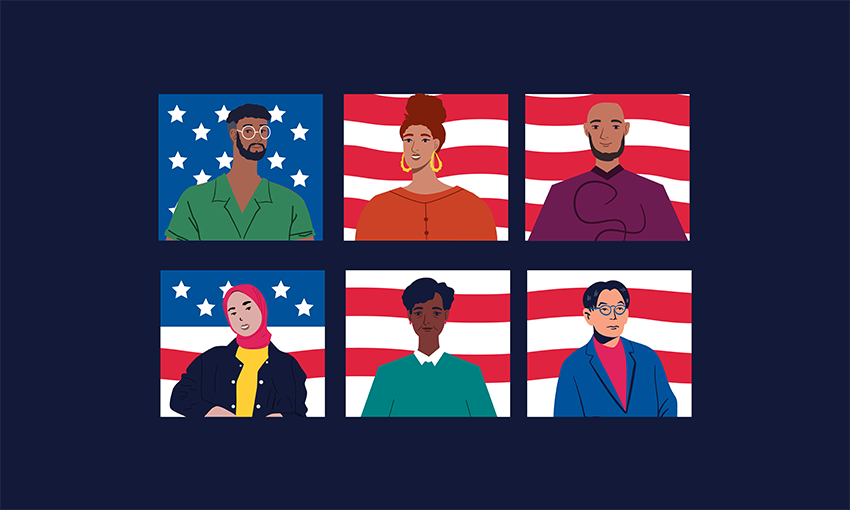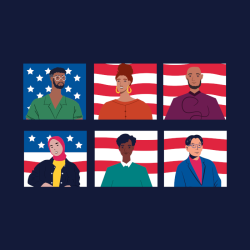How an American Journey is Inspiring OIT’s Transformation

It has been said that the work we do reflects who we are and how we came to be.
Rajiv Uppal’s vision for OIT is very much a reflection of his own journey to America and how he learned to embrace new ways of doing things as a newcomer in a new land. OIT's Director and Chief Information Officer wants OIT to be just as welcoming, inviting, and open to new ideas as the country he fell in love with more than 35 years ago.
Today, much of what he learned about personal growth and change in his American journey is being applied in ways that are fundamentally reshaping OIT from the inside out, creating a more collaborative work environment and a more pleasant customer experience.
Uppal spoke about his experiences and vision for OIT at the July Culture Co-Lab meeting. These monthly forums are designed to stimulate conversations, share defining experiences, nurture new ideas, and connect employees in ways that align with OIT’s key principles as the organization evolves.
With Independence Day as a backdrop, Uppal wanted to share what he has learned in his American journey, while also looking back at how much OIT has evolved.
“When I first came here as a student at LSU, I traveled around the country a lot and was surprised at how polite and welcoming Americans were,” Uppal says. “I think it’s important that we are all welcoming to newcomers, each other, and new ideas.”
So today, just as Uppal was welcomed to this country by Americans, newcomers are welcomed into CMS and OIT by receiving “the necessary information and services to start their careers off right.” Many of these early cultural experiences come through CMS’s New Employee Orientation (NEO) program.
OIT is also reimagining partner engagement through the Partner Relationship Management Program (PRM). This program fosters embedded collaboration with partners to identify business-backed priorities for future-state capabilities, build consensus on technology needs, share lessons learned, and deliver maximum value.
But that’s just the tip of the iceberg. Many other ongoing efforts throughout OIT are collectively nurturing a more welcoming and collaborative culture by:
- Inviting staff to work on projects outside their immediate workgroups and encouraging cross-organizational collaboration on initiatives of every type.
- Asking employees to speak up when they have good ideas.
- Weaving Diversity, Equity, and Inclusion (DEI) into the fabric of OIT, creating an environment where everyone's perspectives are valued and employees are encouraged to be more welcoming to each other.
- Conducting regular discussion forums, like our All-Staff meeting, where anyone can ask questions and engage with leadership on mission-critical issues.
- Actively seeking feedback and looking for ways to become better partners with customers.
The impact of this approach goes beyond the scope of these individual efforts.
“We all know the world around us is changing faster than ever,” Uppal says. “We may not always have the time to get to know people and build the relationships we need to get things done. But collectively, these efforts are enabling us to jump in and make those vital connections sooner.”
At the same time, welcoming cultures are open to new possibilities and not afraid to take prudent risks. This requires reexamining how we define risk, expanding our risk profile definition, and looking carefully at things we once thought were too risky that may now be considered acceptable.
The challenge is how do we better understand, evaluate, and mitigate risks?
There’s no single answer here, but Uppal maintains the path forward must surely include encouraging everyone to innovate, experiment, and take a different view on the way they see risk. One way this is happening is through “Shark Tank”-style pitches, where OIT employees propose innovative approaches to solving problems or improving work processes.
Another way we are redefining risk management is by urging employees to re-think business decisions and looking at them through a "risk lens" instead of just a "compliance lens."
Uppal points out that changing risk tolerances can be tricky because our risk perceptions and what we consider to be normal are often culturally based and deep-seated.
Growing up in India, Uppal said it was common to see people riding atop moving trains and setting off fireworks and explosions during Diwali, the Indian festival of lights.
“We would consider it dangerous here, but it is acceptable in India, which has a higher-risk lifestyle than in the U.S.,” he says. “I wouldn’t recommend doing that, but the example illustrates how much of our risk tolerance comes from our cultural upbringing.”
He adds that it’s important to remember that if we want to continuously improve, we have to expand our risk profiles and try new things. “We’re asking our people to continually look at what they’re doing, what can we change, and what can we do better,” Uppal says.
Citing his own personal growth journey as a father and grandfather, Uppal reminds everyone that learning - both personal and professional - is a never-ending process.
He continues to search for new ways to make OIT more agile and open to ideas and innovation that will deliver better, higher-value services and pleasant experiences to OIT’s partners.
As examples, he cites OIT’s Workforce Resilience program and continuous improvement initiatives. Both are outgrowths of this approach because they seek to deploy lessons learned in ways that encourage innovation, growth, moving forward and further learning.
Looking ahead, Uppal’s approach to culture change remains one of reflection, learning from successes and failures, applying the lessons, and moving forward.
“It's valuable to take time to look at and remember where you were and celebrate how far you have come,” he says. “And we’ve accomplished a lot. But it's equally important to understand that where we are now isn't where we will be in five or 10 years from now.”
For more on Rajiv’s vision for OIT, watch this video retrospective that focuses on programs and initiatives that are helping to reshape OIT’s culture.

